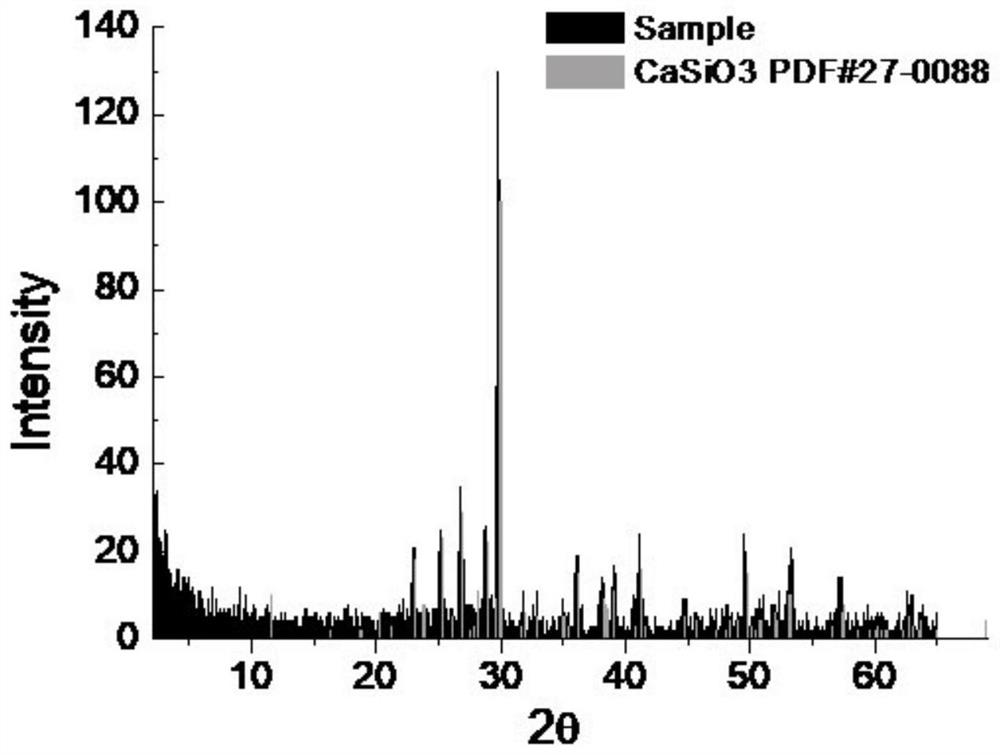Low-temperature sintered glass ceramic powder as well as preparation method and application thereof
A technology of glass ceramics and low-temperature sintering, which is applied in the field of functional ceramics. It can solve the problems of high high-frequency loss and large variation of dielectric constant with frequency, and achieve the effects of reducing content, reducing dielectric constant and thermal expansion coefficient, and solving poor matching.
- Summary
- Abstract
- Description
- Claims
- Application Information
AI Technical Summary
Problems solved by technology
Method used
Image
Examples
Embodiment 1
[0036]Embodiment 1: the preparation method of the low-temperature sintered glass-ceramic powder of the present embodiment, the specific steps are as follows:
[0037] S1. Preparation of the first powder: weigh 10 parts by mass of B 2 o 3 , 45 parts by mass of CaO and 45 parts by mass of SiO 2 , after fully mixing, place in a corundum crucible or a platinum crucible for melting, the melting temperature is 1400°C, and the melting time is 30 minutes to obtain a melt, which is poured into water for quenching. After drying the quenched melt, the particle size after ball milling was 5 μm. Then it was placed in a muffle furnace for heat treatment, the heating temperature of the heat treatment was 850° C., and the heating time of the heat treatment was 1 h to obtain the first powder.
[0038] S2. Preparation of the second powder: Weigh 20 parts by mass of H 3 BO 3 , 40 parts by mass of CaO and 40 parts by mass of C 8 h 20 Si, after being fully mixed, was dissolved in water at a...
Embodiment 2
[0041] Embodiment 2: The preparation method of the low-temperature sintered glass-ceramic powder of this embodiment is basically the same as the steps of Embodiment 1, and will not be repeated here. The difference is:
[0042] S1. Preparation of the first powder: weigh 5 parts by mass of B 2 o 3 , 47.5 parts by mass of CaO and 47.5 parts by mass of SiO 2 . After fully mixing, place it in a corundum crucible or a platinum crucible for melting. The melting temperature range is 1500°C, and the particle size after ball milling is 3-4 μm. The heating temperature of the heat treatment was 800°C.
[0043] S2. Prepare the second powder: weigh 25 parts by mass of H 3 BO 3 , 37.5 parts by mass of CaO and 37.5 parts by mass of C 8 h 20 Si, after being thoroughly mixed, was dissolved in water at a concentration of 10 wt%.
[0044] S3. Mixing: mixing the first powder and the second powder in a mass ratio of 8:1.
[0045] In order to facilitate subsequent verification of the perfor...
Embodiment 3
[0046] Embodiment 3: The preparation method of the low-temperature sintered glass-ceramic powder of this embodiment is basically the same as the steps of Embodiment 1, and will not be repeated here. The difference is:
[0047] S1. Preparation of the first powder: weigh 10 parts by mass of B 2 o 3 , 50 parts by mass of CaO and 40 parts by mass of SiO 2 . The particle size after ball milling is 5-8 μm. The heating temperature of the heat treatment is 780°C, and the heating time of the heat treatment is 1.5h.
[0048] S2. Preparation of the second powder: Weigh 20 parts by mass of H 3 BO 3 , 50 parts by mass of CaO and 30 parts by mass of C 8 h 20 Si, after thorough mixing, was dissolved in water at a concentration of 6 wt%. The particle size of the second powder is 50nm.
[0049] S3. Mixing: mixing the first powder and the second powder in a mass ratio of 4:1.
[0050] In order to facilitate subsequent verification of the performance of the low-temperature sintered gla...
PUM
| Property | Measurement | Unit |
|---|---|---|
| particle diameter | aaaaa | aaaaa |
| particle diameter | aaaaa | aaaaa |
| particle diameter | aaaaa | aaaaa |
Abstract
Description
Claims
Application Information
 Login to View More
Login to View More - R&D
- Intellectual Property
- Life Sciences
- Materials
- Tech Scout
- Unparalleled Data Quality
- Higher Quality Content
- 60% Fewer Hallucinations
Browse by: Latest US Patents, China's latest patents, Technical Efficacy Thesaurus, Application Domain, Technology Topic, Popular Technical Reports.
© 2025 PatSnap. All rights reserved.Legal|Privacy policy|Modern Slavery Act Transparency Statement|Sitemap|About US| Contact US: help@patsnap.com



